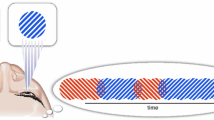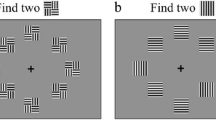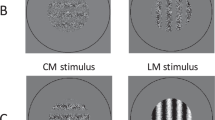Abstract
The neural basis of binocular rivalry has beenthe subject of vigorous debate. Do discrepantmonocular patterns rival for awareness becauseof neural competition among patternrepresentations or monocular channels? In thisarticle, I briefly review psychophysical andneurophysiological evidence pertaining to boththeories and discuss important new neuroimagingdata which reveal that rivalry is fullyresolved in monocular visual cortex. These newfindings strongly suggest that interocularcompetition mediates binocular rivalry and thatV1 plays an important role in the selection ofconscious visual information. They furthersuggest that rivalry is not a unitaryphenomenon. Interocular competition may fullyaccount for binocular rivalry whereas aseparate mechanism involving patterncompetition likely accounts for monocular andstimulus rivalry.
Similar content being viewed by others
References
Andrews, T.J. andPurves, D., 1997: Similarities in normal and binocularly rivalrous viewing. Proc Natl Acad Sci USA 94(18), 9905-9908.
Atkinson, J.,Campbell, F.W.,Fiorentini, A. andMaffei, L., 1973: The dependence of monocular rivalry on spatial frequency. Perception 2(2), 127-133.
Azzopardi, P. andCowey, A., 1997: Is blindsight like normal, near-threshold vision? Proc Natl Acad Sci USA 94(25), 14190-14194.
Barbur, J.L.,Watson, J.D.,Frackowiak, R.S. andZeki, S., 1993: Conscious visual perception without V1. Brain 116(Pt 6), 1293-1302.
Blake, R., 1989: A neural theory of binocular rivalry. Psychological Review 96(1), 145-167.
Blake, R. andBoothroyd, K., 1985: The precedence of binocular fusion over binocular rivalry. Perception and Psychophysics 37(2), 114-124.
Blake, R. andFox, R.: 1974, Adaptation to invisible gratings and the site of binocular rivalry suppression. Nature 249(456), 488-490.
Blake, R.,O'shea, R.P. andMueller, T.J., 1992: Spatial zones of binocular rivalry in central and peripheral vision. Vis Neurosci 8(5), 469-478.
Blake, R. andOverton, R., 1979, The site of binocular rivalry suppression. Perception 8(2), 143-152.
Blake, R.,Westendorf, D.H. andOverton, R., 1980: What is suppressed during binocular rivalry? Perception 9(2), 223-231.
Borsellino, A.A.,De Marco, A. andAllazetta, A., 1972: Reversal time distribution in the perception of visual ambiguous stimuli. Kybernetik 10, 139-144.
Boynton, G.M.,Demb, J.B.,Glover, G.H. andHeeger, D.J., 1999: Neuronal basis of contrast discrimination. Vision Res 39(2), 257-269.
Breese, B.B., 1899: On inhibition. Psychological Monographs 3(1), 1-65.
Brown, R.J. andNorcia, A.M., 1997: A method for investigating binocular rivalry in real-time with the steady-state VEP. Vision Res 37(17), 2401-2408.
Cobb, W.A.,Morton, H.B. andEttlinger, G., 1967: Cerebral potential evoked by pattern reversal and their suppression in visual rivalry. Nature 216, 1123-1125.
Crick, F. andKoch, C., 1995: Are we aware of neural activity in primary visual cortex? Nature 375(6527), 121-123.
Dayan, P., 1998: A hierarchical model of binocular rivalry. Neural Comput 10(5), 1119-1135.
Diaz-Caneja, E., 1928: Sur l'alternance binoculaire. Annales d'Oculistique 165, 721-731.
DuTour, E.-F., 1760: Discussion d'une question d'optique, l'Académie des Sciences. Mémoire de mathémathique et de physique présentés par Divers Savants 3, 514-530.
Engel, S.A.,Rumelhart, D.E.,Wandell, B. A.,Lee, A.T.,Glover, G.H.,Chichilnisky, E.J. andShadlen, M.N., 1994: fMRI of human visual cortex. Nature 369(6481), 525.
Fahle, M., 1987: Naso-temporal asymmetry of binocular inhibition. Invest Ophthalmol Vis Sci 28(6), 1016-1017.
Fox, R. andCheck, R., 1972: Independence between binocular rivalry suppression duration and magnitude of suppression. J Exp Psychol 93(2), 283-289.
Fox, R. andHerrmann, J., 1967: Stochastic properties of binocular rivalry alternations. Perception and Psychophysics 2, 432-436.
Halgren, E.,Dale, A.M.,Sereno, M.I.,Tootell, R.B.,Marinkovic, K. andRosen, B.R., 1999: Location of human face-selective cortex with respect to retinotopic areas. Human Brain Mapping 7(1), 29-37.
Halpern, D.L.,Patterson, R. andBlake, R., 1987: Are stereoacuity and binocular rivalry related? Am J Optom Physiol Opt 64(1), 41-44.
Heeger, D.J.,Huk, A.C.,Geisler, W.S. andAlbrecht, D.G., 2000: Spikes versus BOLD: what does neuroimaging tell us about neuronal activity? Nat Neurosci 3(7), 631-633.
Helmholtz, H. v., 1924: Helmholtz's Treatise on Physiological Optics (J.P.C. Southall, Trans.), Rochester, New York: The Optical Society of America.
Hering, E., 1977: The Theory of Binocular Vision (B. Bridgeman, Trans.), New York: Plenum (original work published 1868).
Horton, J.C.,Dagi, L.R.,McCrane, E.P. andde Monasterio, F.M., 1990: Arrangement of ocular dominance columns in human visual cortex. Arch Ophthalmol 108(7), 1025-1031.
Hubel, D.H. andWiesel, T.N., 1962: Receptive fields, binocular interaction, and functional architecture in the cat's visual cortex. Journal of Physiology 160, 106-154.
Hubel, D.H. andWiesel, T.N., 1968: Receptive fields and functional architecture of monkey striate cortex. Journal of Physiology 195(1), 215-243.
Kovács, I.,Papathomas, T.V.,Yang, M. andFeher, A., 1996: When the brain changes its mind: interocular grouping during binocular rivalry. Proc Natl Acad Sci USA 93(26), 15508-15511.
Kwong, K.K.,Belliveau, J.W.,Chesler, D.A.,Goldberg, I.E.,Weisskoff, R.M.,Poncelet, B.P.,Kennedy, D.N.,Hoppel, B.E.,Cohen, M.S. andTurner, R., 1992: Dynamic magnetic resonance imaging of human brain activity during primary sensory stimulation. Proc Natl Acad Sci USA 89(12), 5675-5679.
Lack, L.C., 1970: Effects of knowledge of results and spacing of practice trials in training of control of binocular rivalry. Percept Mot Skills 31(3), 827-830.
Lack, L.C., 1978: Selective Attention and the Control of Binocular Rivalry, The Hague, The Netherlands: Mouton.
Lansing, R.W., 1964: Electroencephalographic correlates of binocular rivalry in man. Science 146, 1325-1327.
Lee, S.H. andBlake, R., 1999: Rival ideas about binocular rivalry. Vision Res 39(8), 1447-1454.
Lehky, S.R., 1988: An astable multivibrator model of binocular rivalry. Perception 17(2), 215-228.
Lehky, S.R. andBlake, R., 1991: Organization of binocular pathways: Modeling and data related to rivalry. Neural Computation 3(1), 44-53.
Lehmkuhle, S.W. andFox, R., 1975: Effect of binocular rivalry suppression on the motion aftereffect. Vision Res 15(7), 855-859.
Leopold, D.A., 1997: Brain Mechanisms of Visual Awareness. Unpublished doctoral dissertation, Baylor College of Medicine, Houston.
Leopold, D.A. andLogothetis, N.K., 1996: Activity changes in early visual cortex reflect monkeys' percepts during binocular rivalry. Nature 379(6565), 549-553.
Leopold, D.A. andLogothetis, N.K., 1999: Multistable phenomena: changing views in perception. Trends in Cognitive Sciences 3(7), 254-264.
LeVay, S.,Connolly, M.,Houde, J. andVan Essen, D.C., 1985: The complete pattern of ocular dominance stripes in the striate cortex and visual field of the macaque monkey. J Neurosci 5(2), 486-501.
Levelt, W.J.M., 1965: On Binocular Rivalry, Assen, The Netherlands: Royal VanGorcum.
Liu, H. andGao, J., 2000: An investigation of the impulse functions for the nonlinear BOLD response in functional MRI. Magn Reson Imaging 18(8), 931-938.
Liu, L.,Tyler, C.W. andSchor, C.M., 1992: Failure of rivalry at low contrast: Evidence of a suprathreshold binocular summation process. Vision Res 32(8), 1471-1479.
Logothetis, N.K., 1998: Single units and conscious vision. Philos Trans R Soc Lond B Biol Sci 353(1377), 1801-1818.
Logothetis, N.K.,Leopold, D.A. andSheinberg, D.L., 1996: What is rivalling during binocular rivalry? Nature 380(6575), 621-624.
Logothetis, N.K. andSchall, J.D., 1989: Neural correlates of subjective visual perception. Science 245, 761-763.
Lumer, E.D.,Friston, K.J. andRees, G., 1998: Neural correlates of perceptual rivalry in the human brain. Science 280(5371), 1930-1934.
Makous, W. andSanders, R.K., 1978: Suppressive interactions between fused patterns. In J.C. Armington,J. Krauskopf andB.R. Wooten (eds), Visual Psychophysics and Physiology, New York: Academic Press, pp. 167-179.
Matsuoka, K., 1984: The dynamic model of binocular rivalry. Biol Cybern 49(3), 201-208.
Menon, R.S. andGoodyear, B.G., 1999: Submillimeter functional localization in human striate cortex using BOLD contrast at 4 Tesla: implications for the vascular point-spread function. Magn Reson Med 41(2), 230-235.
Menon, R.S.,Luknowsky, D.C. andGati, J.S., 1998: Mental chronometry using latency-resolved functional MRI. Proc Natl Acad Sci USA 95(18), 10902-10907.
Menon, R.S.,Ogawa, S.,Strupp, J.P. andUgurbil, K., 1997: Ocular dominance in human V1 demonstrated by functional magnetic resonance imaging. J Neurophysiol 77(5), 2780-2787.
O'shea, R.P., 1999: Translation of Dutour (1760) [On-line]. Available: http://psy.otago.ac.nz:800/ r_oshea/dutour60.html.
O'shea, R.P. and Crassini, B., 1981: Interocular transfer of the motion after-effect is not reduced by binocular rivalry. Vision Res 21(6), 801-804.
Ogawa, S.,Tank, D.W.,Menon, R.,Ellermann, J.M.,Kim, S.G.,Merkle, H. andUgurbil, K., 1992: Intrinsic signal changes accompanying sensory stimulation: functional brain mapping with magnetic resonance imaging. Proc Natl Acad Sci USA 89(13), 5951-5955.
Polonsky, A.,Blake, R.,Braun, J. andHeeger, D.J., 2000: Neuronal activity in human primary visual cortex correlates with perception during binocular rivalry. Nature Neuroscience 3(11), 1153-1159.
Rees, G.,Friston, K. andKoch, C., 2000: A direct quantitative relationship between the functional properties of human and macaque V5. Nat Neurosci 3(7), 716-723.
Rodman, H.R.,Gross, C.G. andAlbright, T.D., 1989: Afferent basis of visual response properties in area MT of the macaque. I. Effects of striate cortex removal. J Neurosci 9(6), 2033-2050.
Sengpiel, F.,Baddeley, R.J.,Freeman, T.C.,Harrad, R. andBlakemore, C., 1998: Different mechanisms underlie three inhibitory phenomena in cat area 17. Vision Res 38(14), 2067-2080.
Sereno, M.I.,Dale, A.M.,Reppas, J.B.,Kwong, K.K.,Belliveau, J.W.,Brady, T.J.,Rosen, B.R. andTootell, R. B., 1995: Borders of multiple visual areas in humans revealed by functional magnetic resonance imaging. Science 268(5212), 889-893.
Sheinberg, D.L. andLogothetis, N.K., 1997: The role of temporal cortical areas in perceptual organization. Proc Natl Acad Sci USA 94(7), 3408-3413.
Stoerig, P. andCowey, A., 1997: Blindsight in man and monkey. Brain 120(Pt 3), 535-559.
Stoerig, P.,Kleinschmidt, A. andFrahm, J., 1998: No visual responses in denervated V1: Highresolution functional magnetic resonance imaging of a blindsight patient. Neuroreport 9(1), 21-25.
Sugie, N., 1982: Neural models of brightness perception and retinal rivalry in binocular vision. Biol Cybern 43(1), 13-21.
Tong, F. andEngel, S.A., 2001: Interocular rivalry revealed in the human cortical blind-spot representation. Nature 411, 195-199.
Tong, F.,Nakayama, K.,Vaughan, J.T. andKanwisher, N., 1998: Binocular rivalry and visual awareness in human extrastriate cortex. Neuron 21(4), 753-759.
Tononi, G.,Srinivasan, R.,Russell, D.P. andEdelman, G.M., 1998: Investigating neural correlates of conscious perception by frequency-tagged neuromagnetic responses. Proc Natl Acad Sci USA 95(6), 3198-3203.
Tootell, R.B.H.,Hadjikhani, N.K.,Vanduffel, W.,Liu, A.K.,Mendola, J.D.,Sereno, M.I. andDale, A.M., 1998: Functional analysis of primary visual cortex (V1) in humans. Proc Natl Acad Sci USA 95, 811-817.
Wade, N.J., 1975: Monocular and binocular rivalry between contours. Perception 4(1), 85-95.
Wade, N.J. andWenderoth, P., 1978: The influence of colour and contour rivalry on the magnitude of the tilt after-effect. Vision Res 18(7), 827-835.
Wales, R. andFox, R., 1970: Increment detection thresholds during binocular rivalry suppression. Perception and Psychophysics 8(2), 90-94.
Walls, G.L., 1954: The filling in process. American Journal of Optometry and Archives of American Academy of Optometry 31, 329-341.
Wheatstone, C., 1838: Contributions to the physiology of vision-Part the first. On some remarkable and hitherto unobserved phenomena of binocular vision. Philosophical Transactions of the Royal Society of London 128, 371-394.
Author information
Authors and Affiliations
Rights and permissions
About this article
Cite this article
Tong, F. Competing Theories of Binocular Rivalry: A Possible Resolution. Brain and Mind 2, 55–83 (2001). https://doi.org/10.1023/A:1017942718744
Issue Date:
DOI: https://doi.org/10.1023/A:1017942718744




